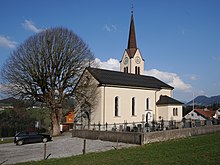Expositurkirche Müselbach
The Expositurkirche Müselbach belongs to the Alberschwende parish . It stands in the district of Müselbach on the slope between Bregenzer Ach and Bregenzerwaldstrasse in the municipality of Alberschwende in the Bregenzerwald in the state of Vorarlberg . It is consecrated to the Sacred Hearts of Jesus and Mary . The church belongs to the dean's office in Bregenz in the diocese of Feldkirch .
history
In September 1497 eight owners of a chapel in Müselbach asked for their consecration in order to be able to attend a mass there from time to time. Since the village of Müselbach was over an hour from the Alberschwende parish church , the residents received a consecrated chapel so early. In 1867, at the suggestion of the pastor in Alberschwende, the chapel was elevated to a branch church with its own priest for the Alberschwende parish. The costs for this had to be borne by the residents, for example a rectory had to be built as a residence for the priest. On May 9, 1868, Johann Mähr was elected the first expositus of Müselbach. His successor, Ferdinand Walch from Schwarzenberg , collected money for a new church soon after his employment. The first draft by the architect Josef Vonstadl was not approved due to the high construction costs, only the second proposal by Seraphin Pümpel, the former city architect of Feldkirch , was approved. In 1880 the demolition of the old Ruperti Chapel began. On June 23, 1883 the new church was consecrated by the vicar general Simon Aichner . On January 31, 1887, the cemetery around the church was consecrated. This eliminated the transport of the dead via Poststrasse to Alberschwende. The small bell or weather bell from 1581, which originally hung in the Ruperti Chapel, now hangs in the bell tower. During the First World War , three bells were withdrawn from Emperor Franz Joseph I for war purposes. In May 1923 the parish bought two new bells, which were picked up again on June 17, 1942 and melted down for war purposes. On November 18, 1956, the church in Müselbach received three new bells, financed by donations from the population, which together with the old bell ring in the four-tone f sharp-a-c sharp-e. They were cast by the Grassmayr bell foundry in Innsbruck . The church was renovated between 1980 and 1982.
Building description
The church is a simple hall building with a gable roof . The choir has moved in. In the northern corner of the choir there is the church tower with a gabled spire and in the southern corner there is the sacristy. On the upper floor of the tower are arched sound windows , on the choir and on the nave there are high and narrow arched windows. An arched frieze runs under the eaves . The portal on the west side was designed in the neo-Romanesque style with a classifying triangular gable and simple column walls . On the south side is a simple arched portal .
The nave is three-bay with a flat barrel vault and stitch caps that rest on simple pilasters . The wooden organ gallery rests on thin columns. The choir is single yoke and has a 3/8 end. On the side walls of the choir there are arched portals that lead to the sacristy and the ground floor of the tower. There are wall paintings in the choir showing God the Father and the four evangelists . They come from Engelbert Luger from 1888. The wall paintings in the nave deal with subjects related to the Sacred Heart. They were created around 1940.
The glass windows were made by the Tyrolean Glass Painting Company in 1940 and 1941 . In the choir they show the " risen One ", the "liberation of Peter ", and the "beheading of Paul ". In the nave they show St. Anne on the left , "Jesus heals the blind" and the " Child blessing of Jesus ". On the right side, St. Joseph , the " Our Father " and the "Baptism of Duke Theodo II by St. Rupert " are shown.
Furnishing
The altars built around 1885. The high altar is a Retabelaufbau with Giebeltabernakel and pinnacles . There are relics in the glazed niches . On the altar table are reliefs by F. Schmalzl from Val Gardena . They show the "sacrifice of Melchizedech ", " Moses before the burning bush" and " Abraham and Isaac ".
The side altars have a high predella zone with niches and an aedicule structure . On the left the "Death of St. Joseph", the Saints Agnes and Aloisius , the tablets of the law and the " Noah's Ark " are shown. On the right side altar are a Pietà , the "Saint Anna teaches Mary to read " and Saints Joachim , Antonius , Rupert and Francis of Assisi .
The pulpit from 1885 is decorated with figures of Moses and the four evangelists. On the back wall is a picture of St. Sebastian . The organ case in the neo-renaissance style was completed in 1885. In the same year the prayer benches, the choir grille and the choir stalls were created. The crucifix was made at the end of the 19th century. The Stations of the Cross are peasant works from the early 19th century that were painted over.
Web links
literature
- DEHIO manual. The art monuments of Austria: Vorarlberg. Alberschwende. Expositurkirche Müselbach. Bundesdenkmalamt (Ed.), Verlag Anton Schroll & Co, Vienna 1983, ISBN 3-7031-0585-2 , pages 2f.
- Arthur Maldoner: 100 years of the Parish Church in Müselbach. In: Heimatpflegeverein Bregenzerwald (Ed.): Bregenzerwald-Heft. Volume 2, Alberschwende, 1983
Individual evidence
- ↑ Maldoner p. 78ff.
Coordinates: 47 ° 27 '18.4 " N , 9 ° 52' 43.3" E



